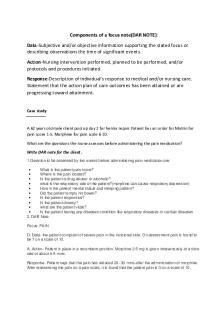Avon case study - note PDF

| Title | Avon case study - note |
|---|---|
| Author | Tien Phamnguyen |
| Course | Strategy |
| Institution | University of Manchester |
| Pages | 3 |
| File Size | 54.8 KB |
| File Type | |
| Total Downloads | 57 |
| Total Views | 130 |
Summary
What strategy was Avon pursuing until mid 2005?‐ Until the mid-2000s, Avon was using the international strategy which is directly to sales model. Regarding to market penetration, Avon gave country managers considerable autonomy; therefore, they used Avon brand name and adopted the direct sales model...
Description
1. What strategy was Avon pursuing until mid‐ 2005? Until the mid-2000s, Avon was using the international strategy which is directly to sales model. Regarding to market penetration, Avon gave country managers considerable autonomy; therefore, they used Avon brand name and adopted the direct sales model. Nevertheless, all Avon’s alliance partners who became independent contractor doing intellectual property of the company by selling skin care and makeup products. Many country managers also set up their own local manufacturing operations and supply chains, were responsible for local marketing, and developed their own new products What were the advantages of this strategy? By using this strategy, the firm has gained serval advantages: First of all, the products and brand were extensively marketed and promoted by word of mouth alone. In addition, purchasing the product was relatively easier as well as it helps the unemployed increased. What were the advantages of this strategy? In the other hands, this strategy also would bring some disadvantages for the firm such as lacking of consistency in marketing strategy from market to market. Additionally, the manufacturing operations and supply chains were extensively duplicated. A profusion of new products, many of this were not profitable. Accountability and communication also got issues. Last but not least, a distinct lack of data-driven analysis of new product opportunities 2. What changes did Andrea Jung make in Avon’s strategy after 2005? What were the benefits of these changes? Can you see any drawbacks?
Jung’s turnaround strategy involved several elements Shen hired seasoned managers from well-known consumer product companies She flattened the organisation to improve communication, performance visibility, and accountability Reduced the number of management layers to just eight and laid off 30% of managers Manufacturing was consolidated in a number of regional centres, and supply chain were rationalized, eliminating duplication and reducing costs by more than $1 billion a year Rigorous return-on-investment criteria were introduced to evaluate product profitability as a consequence, 25% of Avon’s product were not discontinued. thew goal was to develop and introduce blockbuster new products that could be positioned as global brands Jung pushed Avon to emphasise its value proposition in every national market, which could be characterised as high quality at a low price. By 2007, this strategy was starting to yield. The company’s performance improved and growth resumed The drawbacks to this strategy were that 30% managers were laid off and 25% of Avon’s products were discontinued. 3. In your opinion, to what extent were Avon’s problems in 2010‐2011 the result of its chosen strategy? Are there alternative explanations for Avon’s troubles?
The reasons were complex In many of its important emerging markets Avon found itself
Increasingly on the defensive against rivals such as P&G
Sale in developed markets suffered because of economic slow down
There were costly operational problems- such as with the implementing information systems Avon also came up under suspicious for a possible violation of the foreign corrupt practices act when It was revealed that some executives in China had been paying bribes to local government officials....
Similar Free PDFs

Avon case study - note
- 3 Pages

ADV320 Avon Case Study
- 1 Pages

AVON
- 26 Pages

Case note final - case note
- 12 Pages

Formative Case Note - Case note
- 1 Pages

Nydam v R CASE NOTE - case note
- 3 Pages

Northouse Case 2 - Case Note
- 3 Pages

Case grid to case note
- 3 Pages

Writing case notes - case note
- 1 Pages

PIA-AVON Ventas
- 33 Pages

Case Note Structure
- 1 Pages

LLB02 Torts Case Note
- 13 Pages

Macy\'s case - note
- 8 Pages
Popular Institutions
- Tinajero National High School - Annex
- Politeknik Caltex Riau
- Yokohama City University
- SGT University
- University of Al-Qadisiyah
- Divine Word College of Vigan
- Techniek College Rotterdam
- Universidade de Santiago
- Universiti Teknologi MARA Cawangan Johor Kampus Pasir Gudang
- Poltekkes Kemenkes Yogyakarta
- Baguio City National High School
- Colegio san marcos
- preparatoria uno
- Centro de Bachillerato Tecnológico Industrial y de Servicios No. 107
- Dalian Maritime University
- Quang Trung Secondary School
- Colegio Tecnológico en Informática
- Corporación Regional de Educación Superior
- Grupo CEDVA
- Dar Al Uloom University
- Centro de Estudios Preuniversitarios de la Universidad Nacional de Ingeniería
- 上智大学
- Aakash International School, Nuna Majara
- San Felipe Neri Catholic School
- Kang Chiao International School - New Taipei City
- Misamis Occidental National High School
- Institución Educativa Escuela Normal Juan Ladrilleros
- Kolehiyo ng Pantukan
- Batanes State College
- Instituto Continental
- Sekolah Menengah Kejuruan Kesehatan Kaltara (Tarakan)
- Colegio de La Inmaculada Concepcion - Cebu


